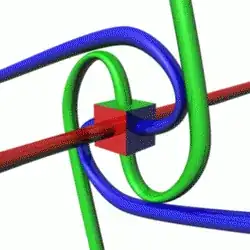I am currently studying the spin-statistics theorem. I have found a section on John Baez's website which presents a "proof" of the spin-statistics theorem. He states the theorem as:
This is a little grab-bag of proofs of the spin-statistics theorem. Quantum mechanics says that if you turn a particle around 360°, its wavefunction changes by a phase of either +1 (that is, not at all) or -1. It also says that if you interchange two particles of the same type, their joint wavefunction changes by a phase of +1 or -1. The spin-statistics theorem says that these are not independent choices: you get the same phase in both cases! The phase you get by rotating a particle is related to its spin, while the phase you get by switching two goes by the funny name of "statistics". The spin-statistics theorem says how these are related.
Then, he states the proof as:
The "proof" is topological, in that if you rotate a thing (particle) with strings all over it, the strings are all twisted after 360 degrees of rotation, but after 720 degrees the strings can be untangled without moving the object. Similarly, if two things (particles) connected by lots of strings are interchanged, the strings are left twisted up exactly as if one particle had been rotated by 360 degrees. So the conclusion is that interchanging two particles is topologically indistinguishable from a rotation of one particle by 360 degrees — a particle which changes sign after a rotation will be antisymmetric with respect to pairwise interchange.
However, I think I am vastly misunderstanding this argument. First, I do not understand why, if particles were connected by strings, interchanging them would result in the strings being twisted. Secondly, I don't understand why after 720 degrees the strings can be untangled without moving the object. Third, which might be the general underlying confusion, I don't see what axis these rotations are about in general.
Is there a way to understand this argument more explicitly?
